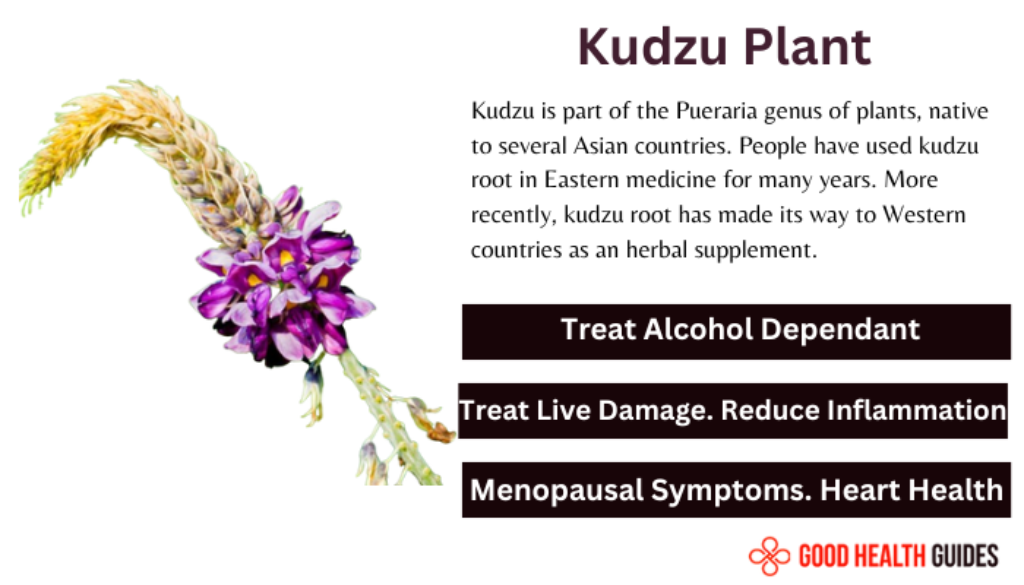Kudzu: Demystify This Potent Yet Pesky 2,000-Year-Old Vine
What is Kudzu?
Kudzu (Pueraria montana or P. lobata) is a climbing, semi-woody perennial vine native to Asia that has become notorious in parts of the United States.
With large compound leaves composed of three broad leaflets and purple, wisteria-like flowers blooming in late summer, it certainly cuts an attractive figure in the plant world. However, kudzu’s famously aggressive growth habits have earned it monikers like “the vine that ate the South.“
Imagine driving down a scenic southern highway, the roads winding through lush forests and past old farmhouses and barns. But instead of seeing the idyllic scenery, your view is obstructed by what appears to be a river of green flowing over the trees, fences, abandoned buildings, and any other surface along the roadside.
That enveloping green blanket is likely kudzu, a plant that can grow up to a foot per day during the hot, humid summer months, quickly smothering anything in its path. Its extensive root system and dense foliage allow it to rapidly outcompete and shade out native flora.
This uncontrolled growth is in stark contrast to kudzu’s homeland in China, Japan, and other parts of Asia where it has existed in relative harmony with local ecosystems for centuries.
So what happened? In the late 1800s, kudzu was initially brought to the United States as an ornamental plant and for soil erosion control. With no natural kudzu predators or pathogens in this new environment to keep it in check, the vine was able to spread uninhibited from its original planting sites in the Southeast.
Its warm weather growth rate and ability to root from nodes along its lengths led to kudzu quite literally vining out of control across millions of acres.
What are the Potential Uses and Benefits of Kudzu?
Despite its noxious and destructive weed reputation in the American Southeast, kudzu’s role as a natural medicine has been revered in traditional Chinese practices for centuries. Its historical uses and potential modern applications include:
- Menopausal Symptoms – The isoflavones in kudzu act as phytoestrogens that may help reduce hot flashes, night sweats, vaginal dryness, and other menopausal symptoms, though large-scale clinical evidence is still lacking. Imagine a simple kudzu supplement taken daily that could make this life transition much more comfortable for millions of women.
- Alcohol Abuse – Multiple small-scale studies suggest kudzu root extracts can reduce alcohol consumption, binge drinking episodes, and heavy drinking days, potentially by increasing the rate of alcohol metabolism and feelings of being “drunk” faster. If these effects could be replicated in larger trials, kudzu could represent a new therapy for alcohol use disorder.
- Diabetes – Kudzu has been used in traditional Chinese medicine for centuries to treat diabetes, though modern clinical evidence has yet to validate this use. The potential lies in kudzu’s ability to influence blood sugar levels, making it an intriguing avenue for future research in glucose regulation.
- Fevers/Colds – Again used traditionally as a fever and cold remedy, but current medical analysis on its efficacy for these purposes is lacking. Many cultures have embraced herbal remedies like kudzu for respiratory viruses and fevers, however, so its role here shouldn’t be discounted entirely.
- Anti-inflammatory/Pain Relief – Some animal research indicates compounds in kudzu, especially when used in combination with other herbs, may have pain-relieving and anti-inflammatory properties that could be applicable for arthritis, injury recovery, or other inflammatory conditions.
Beyond just medicine, kudzu has also served as a versatile food source in its native Asia. The large starchy roots can be prepared similarly to potatoes, sweet potatoes, or yams.
The young vine tips and leaves are edible when cooked as well. The dried and powdered root has even been used as a thickener for soups, sauces, and as a breading for fried foods.

What are the Side Effects of Kudzu?
While generally regarded as safe for short-term use of up to 4 months when taken orally, kudzu does carry some potential side effects to be aware of:
- Mild vaginal irritation from the use of kudzu gels or creams
- Possible liver toxicity, based on some animal studies and a limited number of case reports in humans
- May increase bleeding risk by slowing blood clotting
- Could potentially lower blood sugar levels, requiring monitoring for those with diabetes
Kudzu’s estrogenic effects also mean it is not recommended for people with hormone-sensitive conditions like breast cancer, ovarian cancer, or endometriosis. It may also reduce the effectiveness of fertility medications and the breast cancer drug tamoxifen.
Kudzu: Herb-Drug Interactions
Like many herbal supplements, kudzu can potentially interact with certain medications in ways that alter their absorbed dosage or effects on the body:
- Blood Thinners – Kudzu could increase bleeding risk when combined with anticoagulant/antiplatelet drugs.
- Methotrexate – May impair metabolism of this chemotherapy drug, increasing side effects.
- Tamoxifen – The plant’s estrogenic activity could reduce the effectiveness of this breast cancer medication.
- Hepatotoxic Drugs – Could potentially worsen liver damage from drugs that are hard on the liver.
- Caffeine – Kudzu may slow the body’s metabolism of caffeine, increasing side effects like jitteriness, headache, and rapid heartbeat.
- Diabetes Medications – Kudzu’s potential to lower blood sugar levels could cause a dangerous drop when combined with diabetic drugs.
Whenever starting a new herbal supplement, it’s critical to disclose this to your pharmacist and doctors to check for potential interactions with any existing medications. This can help avoid any unintended compounding of effects.
Kudzu Dosage
Unfortunately, there are no firmly established safe and effective dosage guidelines when it comes to taking kudzu root or extracts as a dietary supplement. Dosages can vary based on the intended therapeutic use, the specific product and formulation, and the manufacturer.
Some general dosages that have been used in preliminary research studies include:
- 50-100 mg per day of the kudzu species Pueraria mirifica for menopausal symptoms
- Around 1.2 grams per day of a kudzu root extract for one week for alcohol dependence
- A single 2-gram dose of kudzu extract taken prior to drinking alcohol to reduce intake
However, it’s important to note that kudzu is not a risk-free supplement, and natural product labels can sometimes be misleading. Always follow dosage instructions on any commercial product labels and consult a doctor or pharmacist, especially if you have an underlying medical condition.
Kudzu: Special Precautions and Warnings
Due to the potential side effects and drug interactions, kudzu supplements should be avoided altogether in certain populations until more safety data is available:
- Pregnancy/Breastfeeding – Effects on the fetus or nursing infant are unknown
- Bleeding/Clotting Disorders – Could increase bleeding risk
- Hormone-Sensitive Conditions – May worsen issues like breast cancer due to estrogenic effects
- Liver Disease – Kudzu has been linked to potential liver injury in some cases
- Prior to Surgery – Could dangerously interfere with blood sugar control
It’s also crucial to discontinue kudzu use at least 2 weeks before any scheduled surgery to prevent potential bleeding or metabolic issues.
How do I get rid of kudzu?
Completely eradicating an established kudzu infestation is an extremely difficult, labor-intensive, and costly process requiring persistence over many years.
Efforts focus on a combination of repeatedly applying herbicides, frequent mowing or controlled burns to deplete the massive root reserves, and grazing by livestock like goats or pigs to repeatedly defoliate the vines.
Even after appearing to kill off kudzu, the hardiest root crowns can remain viable underground for years until conditions are favorable to restart growth. This has made kudzu one of the most challenging and feared invasive plants to control in the United States.
Due to its incredibly thick ground cover, kudzu can also create hazardous areas where the vines grow unchecked for years.
The dense foliage can obscure terrain features, abandoned structures, debris piles, or drop-offs, while the vines themselves present tripping hazards. So in addition to its ecological impacts, kudzu infestations create public safety issues as well.
Ultimately, kudzu’s ability to grow up to 60 feet per season with extensive rooting and spreading capabilities has proved too much for many landowners, farmers, and parks to handle alone.
This has made public education and awareness campaigns about kudzu’s threats crucial to galvanizing communities to action. A variety of non-profit organizations like “Kids Attacking Kudzu” have even emerged to engage young people in kudzu removal efforts.
Pro Tip: Get a Goat-the animal.
Kudzu: Blog Conclusion
The kudzu vine represents one of the most complex intersections of cultural appreciation and ecological calamity in the plant world. To the traditional practitioners of Chinese medicine, it has served as a natural therapy and food source for centuries, carrying respect and perceived healing properties.
Yet this same deep-rooted, vigorously spreading vine has become one of the most infamous and devastating invasive plant threats across the southeastern United States. Kudzu vines snake along highways and smother entire forests, choking out biodiversity with little that can contain its rampant growth.
At the same time, kudzu’s potential benefits for conditions like alcohol abuse, menopausal symptoms, inflammation, and more shouldn’t be dismissed outright. After all, if thoroughly researched and distilled down to standardized compounds, kudzu constituents could possess powerful medicinal value.
Resolving this paradox requires balancing an open scientific mind with steely ecological pragmatism. Kudzu’s therapeutic potential merits rigorous, responsible investigation and research.
But on the invasive weed front, a zero-tolerance policy coupled with public education and aggressive mitigation tactics appears the only way to stem the tide of this conquering vine. Love it or hate it, the kudzu legacy is here to stay.

